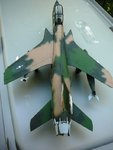Hi Guys,
Another newbie question I guess,
With my past models I've always masked up and painted two or three coloured camoflage and ended up with hard edges at the demarcation. This works for a lot of models however not all!
With my next build, a Tamiya F4-U1D Corsair, I'm looking to try the tri-color White/Grey/Blue paint scheme.
This time however I want a feathered or soft edges where the colours meet.
I have heard of a Blu-tac or plasticine rolled into a "snake" and stuck on where the colours meet and then spraying from a 90 degree angle.
My question(s) are, is this a good technique worth trying? Is there a better way?
I was talking to someone with way more experience than me who said he achieves the effect by manipulating his airbrush needle and pressure. I have no other info for this technique other than that.
Do you guys have other techniques you use? Any suggestions for my experimentation?
Any hints/tips/suggestions would be appreciated!
Cheers, Vengeance
Another newbie question I guess,
With my past models I've always masked up and painted two or three coloured camoflage and ended up with hard edges at the demarcation. This works for a lot of models however not all!
With my next build, a Tamiya F4-U1D Corsair, I'm looking to try the tri-color White/Grey/Blue paint scheme.
This time however I want a feathered or soft edges where the colours meet.
I have heard of a Blu-tac or plasticine rolled into a "snake" and stuck on where the colours meet and then spraying from a 90 degree angle.
My question(s) are, is this a good technique worth trying? Is there a better way?
I was talking to someone with way more experience than me who said he achieves the effect by manipulating his airbrush needle and pressure. I have no other info for this technique other than that.
Do you guys have other techniques you use? Any suggestions for my experimentation?
Any hints/tips/suggestions would be appreciated!
Cheers, Vengeance


